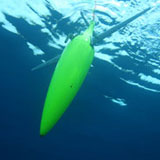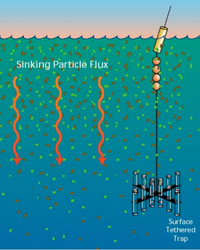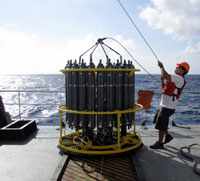- C-MORE Home
- What is Microbial Oceanography?
- What is C-MORE?
- Research
- • Research Cruises
- » BioLINCS
- Home
- Cruise Participants
- Instruments Used
on the Cruise - Nitrogen Cycling
- Marine Microbes
- Cruise Blog
- Data Archive
- Education & Outreach
- People
- Publications
- Image Library
- Contact Us
Instruments Used on the Cruise
During the BioLINCS cruise, researchers will be deploying cutting-edge instrumentation for studying marine microbes in their environment. Some of these instruments undertake experiments that scientists typically perform in the laboratory, robotically, for example, to monitor rates of microbial chemical transformations, and to extract and analyze their DNA. In this case, however, the experiments will run automatically while drifting with ocean currents for days at a time. Other instruments provide information on ocean chemistry and physics around the study site.
SeaGliders

Two SeaGliders—underwater data-collection robots—were sent out from O‘ahu prior to the cruise and will spend the cruise period near Station ALOHA, measuring the water temperature, salinity, and oxygen concentrations at various depths. The SeaGliders also measure the concentration of chlorophyll and of tiny particles in the water—indicators of microbial biomass. This information will be combined with images from satellites to determine the location of any open-ocean eddies near Station ALOHA. Some eddies pull nutrients from deep water up toward the sea surface, spurring the growth of microorganisms, and thereby fueling the food web.
Environmental Sample Processor (ESP)

The Environmental Sample Processor (ESP) is a robotic molecular biology laboratory that collects water samples and analyzes the genetic material of microscopic organisms remotely. This allows researchers to determine how many and what types of microbes are present. The ESP can also detect specific genes that code for proteins performing biochemical functions of interest. The presence of these genes indicates the genetic potential for the process in the environment. The ESP will send some of its data back to researchers on the ship in real time.
During the BioLINCS cruise, researchers will be testing a new version of the ESP, which can collect data while drifting with the ocean currents for days at a time. The ESP will be measuring populations of microbes that take up nitrogen gas from seawater (a process known as nitrogen fixation), by quantifying the genes needed for nitrogen fixation. The ESP was developed and is being deployed by researchers from the Monterey Bay Aquarium Research Institute (MBARI).
Influx Flow Cytometer (IFC)
An influx flow cytometer is a device for rapidly counting and sorting single-celled microbes of specific types and sizes. By shining specially tuned lasers on the cells, the cytometer can separate out and allow scientists to count cells that contain certain pigments or other optically active compounds.
Incubating Productivity System (IPS)

The Incubating Productivity Systems are robotic micro-laboratories that conduct in situ tracer incubation studies for quantifying microbial transformation rates under accurately simulated environmental physico-chemical & optical conditions.
In a timed sequence, a syringe-like incubation chamber is flushed, environmental sample procured & mixed with an appropriate tracer (e.g., 13C-bicarbonate for primary production rates, 15N-ammonia for nitrification rates, etc.) and incubated in situ for a programmed interval. At the end of a given incubation the contents of the incubation chamber is expelled through an in-line filter and into sample bags, where particulate sample & filtrates are chemically preserved for subsequent analysis in the laboratory. To stabilize the sample, preservatives are delivered to the filter surface. At the completion of a given incubation, the incubation chamber is again flushed and the above described sequence repeated, providing automated time-series measurements of the chosen microbial activities for the duration of the cruise. Two IPS instruments will be deployed for in situ measurements of microbial nitrification rates (from 15N-ammonia) at two depths.
Submersible Incubation Device (SID)
During the BioLINCS cruise a larger scale Submersible Incubation Device (4L-SID) will be deployed for time series measurements of 13C-primary production and 15N-nitrogen fixation rates in the upper mixed layer. These incubations are similar to those being conducted by the IPS systems except that ~10x larger samples will be incubated. The SID and the IPS systems were designed and are operated by teams from Woods Hole Oceanographic Institution (WHOI).
Gas Array
A gas array is another type of microbe-incubation device. The chambers in the gas array will be filled with isotopically labeled nitrogen and water collected during CTD casts (see below) and then will be allowed to drift in the ocean for approximately 24 hours. These arrays will allow researchers to study nitrogen-fixation rates from several depths in the ocean.
Lagrangian Sediment Traps

Each Lagrangian sediment trap consists of an array of collection tubes, closed at the bottom and open at the top, that are suspended at various depths in the water column to capture particles sinking down toward the seafloor. During the BioLINCS cruise, a group of sediment traps will be allowed to drift for about eight days. After the traps are brought back on board the ship, researchers will study the chemical content and types of microbes in the collected sediment.
Sinking particles (commonly known as marine snow) provide food for many microbes and larger animals in the deep sea. The particles also carry nitrogen compounds down from the surface waters and into the depths, sometimes all the way to the deep seafloor. Since this material sinks downward, away from light, and from the microbes that can perform photosythesis, it is considered to be lost, or “exported” from the near-surface waters.
CTD Rosettes

These water-collection devices are typically lowered from the ship on a wire, collecting data and water samples as they descend as far as 3,000 meters below the ocean surface. CTD rosettes consist of a ring of plastic tubes with lids that can be closed automatically to collect samples of water from different depths. As the rosette descends through the water column, a sensor attached to the rosette collects information on water conductivity (an indicator of salinity), temperature, and depth (thus the term “CTD” rosette). Other sensors may measure concentrations of oxygen and chlorophyll concentrations (an indicator of photosynthetic microbes). Researchers from the University of Hawai‘i have been making CTD “casts” at Station ALHOA since October 1988.
McLane Pump
The McLane pump allows researchers to filter large volumes of water in the ocean instead of bringing that water on board a ship for filtering. It consists of a high-volume submersible, programmable pump, which is lowered into the ocean and spends several hours at a specific depth, pumping seawater through a two different filters. At the end of a deployment, the pump and filters are brought back to the surface. During a four-hour deployment, a single McLane pump can filter up to 1,800 liters of water.
[ Top of Page ]



